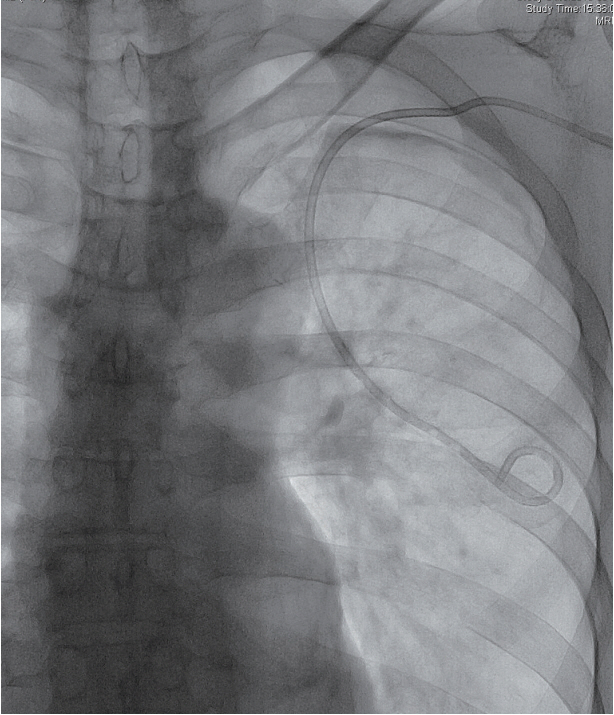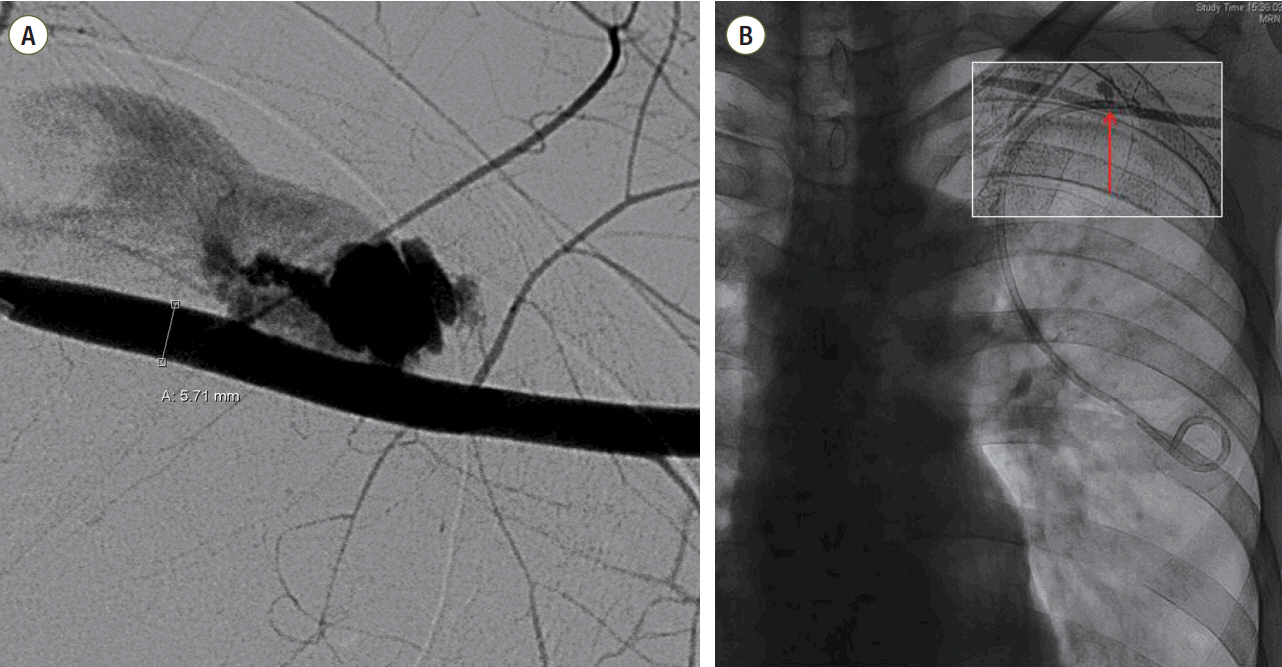Korean J Crit Care Med.
2015 May;30(2):119-122. 10.4266/kjccm.2015.30.2.119.
Subclavian Artery Laceration Caused by Pigtail Catheter Removal in a Patient with Pneumothorax
- Affiliations
-
- 1Department of Anesthesiology and Pain Medicine, Samsung Changwon Hospital, Sungkyunkwan University School of Medicine, Changwon, Korea.
- 2Department of Thoracic and Cardiovascular Surgery, Samsung Medical Center, Sungkyunkwan University School of Medicine, Seoul, Korea. yanghyun.cho@samsung.com
- 3Department of Critical Care Medicine, Samsung Medical Center, Sungkyunkwan University School of Medicine, Seoul, Korea.
- KMID: 2227679
- DOI: http://doi.org/10.4266/kjccm.2015.30.2.119
Abstract
- We report a case of subclavian artery laceration caused by the removal of a pigtail pleural drainage catheter in a patient with a pneumothorax. The patient was successfully resuscitated through diagnostic angiography with subsequent balloon occlusion and primary repair of the injured subclavian artery. Although pigtail drainage of a pneumothorax is known to be safe and effective, proper insertion and removal techniques should be emphasized to reduce the risk of complications.
Keyword
MeSH Terms
Figure
Reference
-
References
1. Kulvatunyou N, Erickson L, Vijayasekaran A, Gries L, Joseph B, Friese RF, et al. Randomized clinical trial of pigtail catheter versus chest tube in injured patients with uncomplicated traumatic pneumothorax. Br J Surg. 2014; 101:17–22.
Article2. Kuo HC, Lin YJ, Huang CF, Chien SJ, Lin IC, Lo MH, et al. Small-bore pigtail catheters for the treatment of primary spontaneous pneumothorax in young adolescents. Emerg Med J. 2013; 30:e17.
Article3. Chen CH, Liao WC, Liu YH, Chen WC, Hsia TC, Hsu WH, et al. Secondary spontaneous pneumothorax: which associated conditions benefit from pigtail catheter treatment? Am J Emerg Med. 2012; 30:45–50.
Article4. Tsai WK, Chen W, Lee JC, Cheng WE, Chen CH, Hsu WH, et al. Pigtail catheters vs large-bore chest tubes for management of secondary spontaneous pneumothoraces in adults. Am J Emerg Med. 2006; 24:795–800.
Article5. Hayes D. Pigtail drain tubes: a guide for nurses. Aust Nurs J. 2005; 12:19–20.6. MacDuff A1, Arnold A, Harvey J; BTS Pleural Disease Guideline Group. Management of spontaneous pneumothorax: British Thoracic Society Pleural Disease Guideline 2010. Thorax. 2010; 65 Suppl 2:ii18–31.
Article7. Makris D, Hatthabi M, Scherpereel A, Lafitte JJ, Marquette CH. Haemothorax after pig-tail catheter removal in a patient with primary spontaneous pneumothorax. Emerg Med J. 2007; 24:e17.
Article8. Rawlins R, Brown KM, Carr CS, Cameron CR. Life threatening haemorrhage after anterior needle aspiration of pneumothoraces. A role for lateral needle aspiration in emergency decompression of spontaneous pneumothorax. Emerg Med J. 2003; 20:383–4.
Article9. Laws D, Neville E, Duffy J; Pleural Diseases Group, Standards of Care Committee, British Thoracic Society. BTS guidelines for the insertion of a chest drain. Thorax. 2003; 58 Suppl 2:ii53–9.
Article
- Full Text Links
- Actions
-
Cited
- CITED
-
- Close
- Share
- Similar articles
-
- Hydrohemothorax and Subclavian Artery Laceration during Internal Jugular Vein Cannulation: A case report
- Swan-Ganz Catheter-Induced Pulmonary Artery Rupture and Atelectasis Caused by a Bronchial Thrombus
- Acute Extrapleural Hematoma Resulting from Right Subclavian Artery Laceration during Internal Jugular Catheterization: A case report
- Pericardial Effusion after Central Venous Catheterization of Subclavian Vein
- Comparison of Therapeutic Effects and Complications between Pigtail Catheter and Conventional Tube Thoracotomy for Pneumothorax in Neonates




